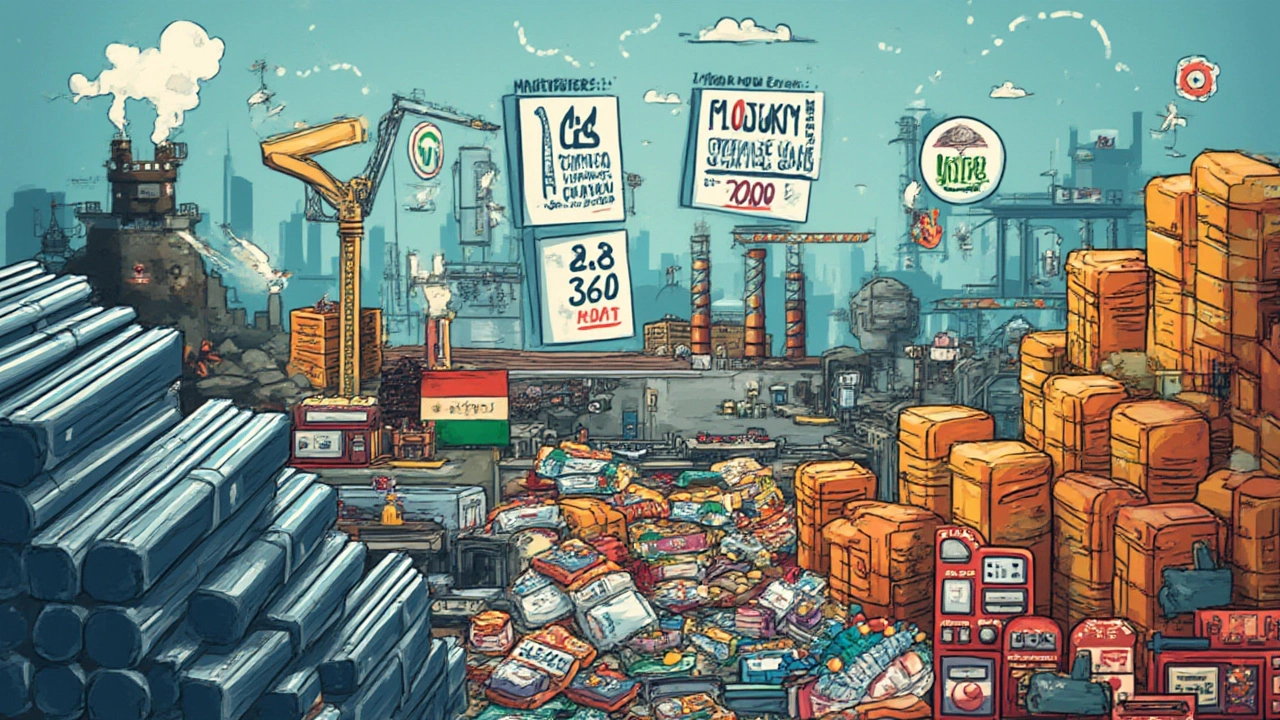You might be surprised to hear that the third-largest manufacturer of pharmaceuticals on earth isn’t the United States, Germany, or Japan—it’s India. The country is known for its high-tech startups and spicy food, but it also cranks out industrial goods at a mind-blowing scale. Forget the outdated picture of dusty factories; walk into any shop in Europe, Africa, or even the US, and there’s a decent chance that at least one product on the shelf says “Made in India.” Yet, most folks outside the country have no real idea just how deep India’s manufacturing runs. What exactly does the world’s most populous country make better—or, at least, more—than nearly anyone else?
Backbone Industries: Where India Shines
India’s manufacturing story isn’t just about one star industry—it’s about an entire orchestra playing in sync. Let’s start with textiles because, let’s be honest, if you’ve ever worn a cotton T-shirt, there’s a wild chance that cotton came from an Indian field or mill. India is the world’s second-largest textile and garment producer, responsible for around 12% of the global output. Every corner of the country buzzes with handloom clusters or massive, buzzing apparel factories. Surat’s synthetic saris, Ludhiana’s sweaters, Tiruppur’s T-shirts—each city’s reputation is built on a specific fabric or style.
Chemicals are another heavyweight. Most people look at bags of fertilizer and see, well, fertilizer. But that industry fuels the breadbasket of India and half of Africa. India is the largest producer of generic medicines. About one out of every five medicines consumed globally comes from Indian pharma giants like Sun Pharma, Dr. Reddy’s, or Cipla. And it’s not all pills. Think colors, inks, and solutions—Indian chemists are especially good at producing basic industrial chemicals at scale.
Now let’s talk about cars and car parts. You’ve seen Japanese or American brands everywhere, but did you know those shiny Honda engines or Ford door handles might have been made in Pune, Chennai, or Gurugram? India is a global hub for auto parts, exporting billions of dollars’ worth every year. Tata Motors, Mahindra & Mahindra, and yes, even Suzuki have sprawling factories in the country. Tractor production alone blows past the rest of the world; Mahindra sold its four millionth tractor in 2023, making it the world’s largest producer.
Steel and cement don’t get Instagram moments, but they’re everywhere—from the rebars in city skyscrapers to the bridges over the Ganges. India is the second-largest steel producer (after China) and churns out more than 120 million tons every year. Look at the new expressways spanning the length of the country: almost every inch is made possible by local steel and cement.
Electronics have exploded in the past decade. Ten years ago, “Made in India” on a smartphone was unheard of. Today, India is the second-largest producer of mobile phones in the world, only behind China. Brands like Samsung, Xiaomi, and Apple assemble millions of phones every year in Indian factories. Foxconn factories are so huge in southern India that some locals call them “cities within cities.” But it’s not just phones—TVs, air conditioners, and other small appliances are now rolling off Indian assembly lines at a pace that would have been impossible to imagine just twenty years ago.
One more surprise: gems and jewelry. Ever heard of Surat? This city cuts and polishes over 90% of the world’s diamonds. India isn’t just about raw diamonds either—it leads in gold jewelry crafting, exporting intricate pieces loved from the Middle East to the USA.

Products That Power India—and the World
Textiles might be the first thing that comes to mind, but if you dig a bit deeper, you’ll spot a wild list of “Made in India” essentials hiding in plain sight. Pharmaceuticals? The world turns to Indian factories in moments of panic. When COVID-19 hit, India earned its nickname as the “pharmacy of the world,” shipping vaccines and drugs across continents. Some US hospitals rely so heavily on Indian generics that if there’s a glitch in India’s supply, pharmacy shelves start looking bare within weeks.
Let’s talk exports for a minute. Every year, India ships out goods worth hundreds of billions of dollars. Back in 2024, India’s merchandise exports hit a record $456 billion according to the government’s Ministry of Commerce. Out of this, engineering goods take the crown—accounts for nearly a quarter of the total. This covers everything from turbines made in Gujarat to car engines from Chennai. The next big chunk? Gems and jewelry, not gold bars, but polished diamonds and bejeweled necklaces straight out of Mumbai and Jaipur. Even small towns specialize—the city of Moradabad, nicknamed “Pital Nagari” (Brass City), is famous for brass handicrafts exported round the world.
Let’s not overlook food. India is the world’s largest producer—and exporter—of spices. Cardamom from Kerala, black pepper from Karnataka, turmeric from Telangana: if you open your kitchen spice rack, there’s a good chance that at least some of those bottles trace their roots straight back to Indian farms. Basmati rice is another heavyweight. Each year, nearly 5 million tons of basmati are packed off to kitchens in the Middle East, Europe, and America. Don’t forget tea—India is right behind China in tea production, and Darjeeling tea is as famous as any French wine. Indian exporters know how to turn the humble leaf into an international luxury.
Automobiles aren’t just for Indians anymore. Compact Maruti-Suzuki and Tata models have fans in Africa and Latin America, not just because they’re cheaper, but because they’re built tough for sometimes rough roads. And those tractors you see ploughing fields from Brazil to Bangladesh? Again, likely made in India. Indian motorcycles from Bajaj and Hero zip through the traffic of Lagos and Nairobi, not just Mumbai and Delhi.
Technology hardware is catching up fast. A decade ago, Indians barely made any computers or electronics at home. Now, India wants to become the next global electronics powerhouse. By 2023, the country was producing over 300 million mobile phones a year, according to the India Cellular and Electronics Association. Local companies, pushed by government programs like “Make in India,” now have a fighting chance to build everything from circuit boards to LED lights. It’s not all high-tech though—India is the biggest producer of basic fans and electric irons, exported to more than 50 countries.
Here’s one you might not expect: bicycles. Ludhiana alone makes more than 10 million bikes each year. If you ride a budget bike in Europe or Africa, don’t be surprised to discover “Made in India” stamped somewhere on the frame. Indian manufacturing often focuses on products the world actually needs, rather than luxury goods. That’s why you find Indian syringes, low-cost eyeglasses, and utility vehicles in countries that can’t afford European or American brands.
And don’t ignore renewable energy. India has become a serious player in manufacturing wind turbines and solar panels, with companies like Suzlon and Tata Power exporting green tech as demand rises globally. It’s part of a fresh push to give China a run for its money in the sustainable energy market.

Tactics, Trends, and the Road Ahead
Indian manufacturing isn’t just about quantity; it’s about getting smarter, faster, and more connected. The days when Indian factories ran on cheap labor and little else are fading. Now, automation and digital tools are making factories look more like those in Japan or Germany. Nearly every big player is investing in robots and data science. Why? Because global customers won’t wait months—they want their goods shipped in weeks with zero defects. Companies like Tata, Reliance, and L&T are putting billions into smart production lines where software tracks every part in real-time.
But here’s a cool twist: traditional skills aren’t going anywhere. India is the only country where you get handmade textiles and mass-produced smartphones within a few miles of each other. Artisans in Kanchipuram weave silk saris on wooden looms, while engineers in Bengaluru 3D-print machine parts. Even big organizations are starting to notice and market these ancient-modern mashups as “heritage tech.”
Government policies have shoved things into high gear. Remember “Make in India” launched back in 2014? That’s what got Apple and Samsung building those monster factories. There are perks for exporters, low taxes for certain zones, and even dedicated freight corridors connecting ports to factories—all designed to chop time and costs. The new PLI (Production-Linked Incentive) scheme dropped in 2020 has already pulled in nearly $30 billion in new investment from electronics, pharma, and automobile makers.
Newer trends are shaping the next decade. Green manufacturing is hot: from electric two-wheelers to solar panel exports, every big business wants to slap a “green” badge on their goods. Makers are investing in recycling, biodegradable packaging, and solar-powered factories. On the ground, the skill gap is shrinking as thousands of training centers across India churn out young workers who know how to run a robot or check a circuit board, not just stitch a shirt.
Supply chain resilience became a buzzword after COVID-19, when factories in China ground to a halt. Suddenly, American and European buyers were hunting for alternatives, and India turned out to be the only country with the sheer scale and skill to jump in. The country’s ports, highways, and airports have been upgraded like never before, with massive projects tying together all corners of India. That means goods made in Kanpur can reach Rotterdam or Sydney faster than ever—sometimes almost overnight.
If you’re looking for the next big investment, keep an eye on sectors like aerospace and defense. India isn’t yet making fighter jets the same way as the US, but homegrown firms like HAL, Bharat Electronics, and a handful of tech startups are making parts for Boeing, Airbus, and even SpaceX satellites. This year, India is expected to export $5 billion worth of defense and aerospace parts, up from almost nothing a decade ago.
Bite-sized takeaway? India manufacturing isn’t some one-trick pony—it’s a multi-headed beast that grows every time you turn around. From high-end drugs and tiny chips to rugged motorcycles and luxury saris, “Made in India” is showing up somewhere in your life already. The variety, scale, and resilience set India apart. If you ever find yourself in a buzzing Indian city or a dusty rural market, take a closer look—you’ll see the country’s manufacturing muscle flexing in every direction.
